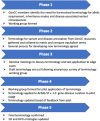This is a preprint.
Towards robust clinical genome interpretation: developing a consistent terminology to characterize disease-gene relationships - allelic requirement, inheritance modes and disease mechanisms
- PMID: 37066232
- PMCID: PMC10104222
- DOI: 10.1101/2023.03.30.23287948
Towards robust clinical genome interpretation: developing a consistent terminology to characterize disease-gene relationships - allelic requirement, inheritance modes and disease mechanisms
Update in
-
Toward robust clinical genome interpretation: Developing a consistent terminology to characterize Mendelian disease-gene relationships-allelic requirement, inheritance modes, and disease mechanisms.Genet Med. 2024 Feb;26(2):101029. doi: 10.1016/j.gim.2023.101029. Epub 2023 Nov 17. Genet Med. 2024. PMID: 37982373 Free PMC article.
Abstract
Purpose: The terminology used for gene-disease curation and variant annotation to describe inheritance, allelic requirement, and both sequence and functional consequences of a variant is currently not standardized. There is considerable discrepancy in the literature and across clinical variant reporting in the derivation and application of terms. Here we standardize the terminology for the characterization of disease-gene relationships to facilitate harmonized global curation, and to support variant classification within the ACMG/AMP framework.
Methods: Terminology for inheritance, allelic requirement, and both structural and functional consequences of a variant used by Gene Curation Coalition (GenCC) members and partner organizations was collated and reviewed. Harmonized terminology with definitions and use examples was created, reviewed, and validated.
Results: We present a standardized terminology to describe gene-disease relationships, and to support variant annotation. We demonstrate application of the terminology for classification of variation in the ACMG SF 2.0 genes recommended for reporting of secondary findings. Consensus terms were agreed and formalized in both sequence ontology (SO) and human phenotype ontology (HPO) ontologies. GenCC member groups intend to use or map to these terms in their respective resources.
Conclusion: The terminology standardization presented here will improve harmonization, facilitate the pooling of curation datasets across international curation efforts and, in turn, improve consistency in variant classification and genetic test interpretation.
Figures
References
-
- Riggs E.R. et al. Technical standards for the interpretation and reporting of constitutional copy-number variants: a joint consensus recommendation of the American College of Medical Genetics and Genomics (ACMG) and the Clinical Genome Resource (ClinGen). Genet Med 22, 245–257 (2020). - PMC - PubMed
-
- Bean L.J.H. et al. Diagnostic gene sequencing panels: from design to report-a technical standard of the American College of Medical Genetics and Genomics (ACMG). Genet Med 22, 453–461 (2020). - PubMed
Publication types
Grants and funding
LinkOut - more resources
Full Text Sources

